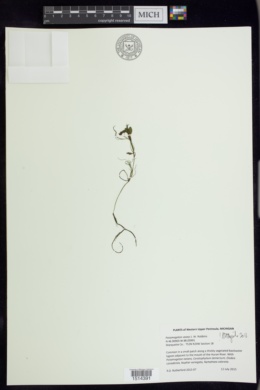Potamogeton vaseyi
|
|
|
|
Family: Potamogetonaceae
Vasey's Pondweed
[Potamogeton vaseyi var. latifolius] |
Rhizomes absent. Cauline stems terete, without spots, 2--5 cm; glands absent. Turions common, axillary, 0.5--2 cm ´ 0.5--1.2 mm, soft; leaves ± 2-ranked; outer leaves 2--3 per side, base not corrugate, apex acute; inner leaves undifferentiated or rolled into tight, hardened structure. Leaves submersed, or both submersed and floating, ± spirally arranged. Submersed leaves sessile, delicate; stipules persistent, inconspicuous, convolute, free from blade, green to brown, not ligulate, 0.4--1.2 cm, not fibrous, not shredding at tip, apex attenuate; blade light green, linear-filiform, not arcuate, 2--8 cm ´ 0.1--1 mm, bases slightly tapering, without basal lobes, not clasping, margins entire, not crispate, apex not hoodlike, acute to almost bristle-tipped, lacunae present, rarely absent, 0--2 rows each side of midvein; veins 1(--3). Floating leaves: petioles continuous in color to apex, 5--25 mm; blade adaxially greenish brown, elliptic, spatulate, or obovate, 0.6--1.5 cm ´ 3--8 mm, base acute, apex obtuse; veins 5--9. Inflorescences unbranched, emersed; peduncles not dimorphic, terminal, ascending in flower, recurved in fruit, cylindric, 5--30 mm; spikes not dimorphic, cylindric or moniliform, 6--8 mm. Fruits sessile, green to brown, obliquely round-obovoid, compressed, abaxially keeled, not laterally keeled, 1.5--2.5 ´ 1.2--1.6 mm; beak erect, 0.3--0.5 mm; sides without basal tubercles; embryo with 1 full spiral. 2n = 28. Flowering and fruiting summer--fall. Quiet waters of lakes, ponds, and rivers; 50--500 m; N.B., Ont., Que.; Conn., Ill., Ind., Iowa, Maine, Mass., Mich., Minn., N.H., N.J., N.Y., Ohio, Pa., R.I., Vt., Wis. All of the original material of Potamogeton lateralis Morong, including the collection designated as the lectotype, has been studied (C. B. Hellquist et al. 1988). Every specimen, was a mixed collection of P. pusillus and P. vaseyi. Based on the results of the study, P. lateralis is taxonomically nomenclaturally invalid and should be rejected. Potamogeton vaseyi is an uncommon species that has submersed leaves very similar to P. pusillus subsp. gemmiparus. Floating leaves apparently are present only when the species is fertile, and the species often grows intermixed with that subspecies. Collections are consequently often a mixture of the two taxa. Also, sterile collections of either taxon can easily be mistaken for the other.
Annual submersed aquatic herb 20 cm - 0.5 m tall Stem: freely branched, jointed, often with a pair of nodal glands. Inflorescence: an ascending, cylindrical spike of whorled flowers, emersed, unbranched, 3 - 8 mm long, on a terminal stalk. Stalk cylindrical, slender, 0.5 - 3 cm long. Flowers: greenish, tiny. Stamens four. Anthers two-chambered, with four edge-to-edge sepal-like outgrowths. Fruit: an achene, stalkless, green to brown, 1.5 - 2.5 mm long, 1.2 - 1.6 mm wide, obliquely rounded to reverse egg-shaped, compressed, usually round-keeled, with an upright, 0.3 - 0.5 mm long beak. Submersed leaves: more or less arranged spirally, stalkless, translucent, 2 - 8 cm long, to 1 mm wide, thread-like to linear with a slightly tapering base and pointed tip (or bristle-tipped), typically one-veined (sometimes with two weak lateral veins). Stipules free from leaf blade, brown to green, linear, rolled up, 4 - 12 mm long. Floating leaves: (if present) more or less arranged spirally, on a 0.5 - 2.5 cm long stalk, 6 mm - 1.5 cm long, 3 - 8 mm wide, elliptic to spatula- or reverse egg-shaped with a tapering base and blunt tip, five- to nine-veined, leathery, firmer than submersed leaves. Similar species: No information at this time. Flowering: June to September Habitat and ecology: Very rare in the Chicago Region. Found in lakes and ponds. Occurence in the Chicago region: native Notes: Plants in the genus Potamogeton are very important to wildlife, offering habitat and food for many aquatic animals. Etymology: Potamogeton comes from the Greek words potamos, meaning river, and geiton, meaning neighbor, referring to the habitat of these plants. Vaseyi is named after George Vasey (1822-1893), the American plant collector who discovered this species. Author: The Morton Arboretum thin and transparent, narrowly linear, 2-6 cm נ0.2-
1 mm, sharply acute, 1-nerved or rarely with 2 weak lateral nerves, without lacunar cells; stipular sheaths free, linear, scarcely encircling the stem, 4-10 mm, scarious, weakly fibrous in age; floating lvs rather sparingly produced on at least some plants of a colony, the blade spatulate to obovate, 8-15 mm, 5-9- veined, the spaces between the veins filled by minute, elliptic lacunar cells, the petiole ca as long as the blade; winter-buds 1-3 cm, the inner lvs rolled into a hard, fusiform structure; peduncles slender, 0.5-3 cm; spikes cylindric, 3-8 mm, with 1-4 ±contiguous whorls of fls; fr obovoid, 1.5-2.5 mm, with flat or shallowly pitted sides, with or without a low, rounded dorsal keel; 2n=28. In quiet water; N.B. and s. Que. to Minn., s. to Pa., O., and Ill. (P. lateralis, the name based on a mixture of P. pusillus and P. vaseyi) Gleason, Henry A. & Cronquist, Arthur J. 1991. Manual of vascular plants of northeastern United States and adjacent Canada. lxxv + 910 pp. ©The New York Botanical Garden. All rights reserved. Used by permission. |




















































































